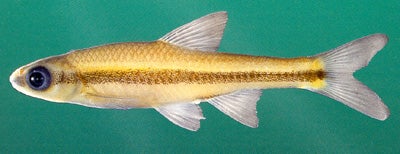IRONCOLOR SHINER
SCIENTIFIC NAME: Notropis chalybaeus
CHARACTERISTICS: This small species of Notropis has a deep, compressed body and a dark, pronounced lateral band extending from the tail to the snout. The inside of the mouth is intensely pigmented, a feature the separates this species from the weed shiner, N. texanus; coastal shiner, N. petersoni; and bluenose shiner, Pteronotropis welaka. Breeding males have a bright orange stripe above the lateral band, and the back is reddish brown with an olive cast. Orange "windows" appear above and below the caudal spot, with an orange cast extending onto the tail. Melanophores outline the anal rays.
ADULT SIZE: 1.6 to 2.2 in. (40 to 55 mm)
DISTRIBUTION: The ironcolor shiner is found in Atlantic and Gulf slope drainages from Maine to Texas, generally in the lower Coastal Plain and infrequently up the Mississippi basin to Michigan. It is distributed sporadically in south Alabama from the Chipola River system west to Big Creek in Mobile County.
HABITAT AND BIOLOGY: Notropis chalybaeus inhabits small, slow, acidic blackwater streams draining swamps and other types of vegetated wetlands of the Southern Pine Hills and lower Dougherty Plains. Marshall (1947) describes its habitat in Florida as sluggish streams with small, quiet pools and shallow, swift blackwaters. This shiner is a sight feeder, consuming adult and immature insects and plant material drifting in the stream. Marshall (1947) reports a protracted spawning season in Florida, from early April through September. Spawning in Alabama likely occurs from April to August. During spawning, females broadcast their eggs in the water columns over sand-bottom pools, where the eggs adhere to sand and gravel particles.
ORIGINAL DESCRIPTION: The ironcolor shiner was described by Cope in 1869.
ETYMOLOGY:
Notropis means keeled back.
Chalybaeus means iron-colored.
The copyrighted information above is from Fishes of Alabama and the Mobile Basin.






